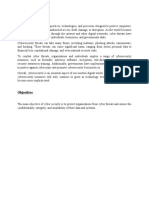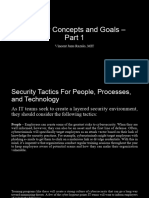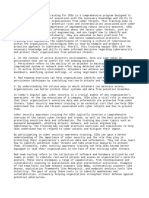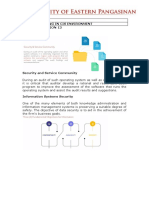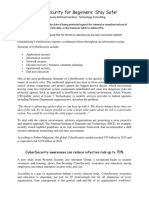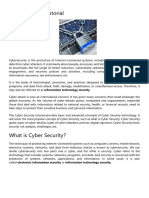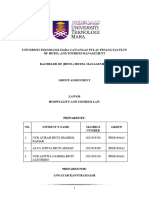Csss
Csss
Uploaded by
ST DOORSCopyright:
Available Formats
Csss
Csss
Uploaded by
ST DOORSOriginal Description:
Original Title
Copyright
Available Formats
Share this document
Did you find this document useful?
Is this content inappropriate?
Copyright:
Available Formats
Csss
Csss
Uploaded by
ST DOORSCopyright:
Available Formats
GLOBAL ATTACK TRENDS
Global Attack Trends:
A cyber attack is any attempt to gain unauthorized access to a computer, computing system or
computer network with the intent to cause damage. Cyber attacks aim to disable, disrupt, destroy
or control computer systems or to alter, block, delete, manipulate or steal the data held within
these systems.Any individual or group can launch a cyber attack from anywhere by using one or
more various attack strategies.
People who carry out cyber attacks are generally regarded as cybercriminals. Often referred to as
bad actors, threat actors and hackers, they include individuals who act alone, drawing on their
computer skills to design and execute malicious attacks. They can also belong to a criminal
syndicate, working with other threat actors to find weaknesses or problems in the computer
systems -- called vulnerabilities -- that they can exploit for criminal gain.
Government-sponsored groups of computer experts also launch cyber attacks. They're identified
as nation-state attackers, and they have been accused of attacking the information technology
(IT) infrastructure of other governments, as well as nongovernment entities, such as businesses,
nonprofits and utilities.
1. Past Threat Landscape of Cybersecurity:
In the past, cybersecurity threats were mainly focused on individual users and their
personal devices. Viruses and malware were spread through email attachments and
software downloads, and attackers used phishing tactics to steal login credentials and
personal information. These attacks were often carried out by individuals or small groups
of hackers, and the impact was generally limited to the individual victims.
2. Present Threat Landscape of Cybersecurity:
Today, the cybersecurity threat landscape has evolved significantly. Attacks are
becoming more sophisticated and are increasingly focused on businesses and
organizations. Ransomware attacks, where attackers encrypt a victim's files and demand
payment in exchange for the decryption key, have become more common and can cause
significant damage to businesses. Phishing attacks have also become more advanced,
with attackers using social engineering techniques to trick users into revealing sensitive
information. Additionally, cyberattacks are often carried out by organized groups,
including criminal organizations and state-sponsored hackers.
3. Future Threat Landscape of Cybersecurity:
Looking to the future, the threat landscape of cybersecurity is expected to continue to
evolve and become even more complex. As more devices become connected to the
internet, including IoT devices and autonomous systems, the attack surface will continue
to grow. Additionally, the use of artificial intelligence (AI) and machine learning (ML)
by both attackers and defenders will create a new dynamic in the cybersecurity landscape.
It is expected that AI and ML will be used by attackers to carry out more sophisticated
attacks, while defenders will use these technologies to detect and respond to attacks more
quickly.
In conclusion, the cybersecurity threat landscape has changed significantly over time and is
expected to continue evolving. To stay protected, individuals and organizations need to stay
vigilant, adopt best security practices, and use the latest security technologies. Additionally,
collaboration between industry, government, and other stakeholders is key to ensuring a secure
and resilient cyberspace.
ORGANIZATIONAL PROCESS:
The cybersecurity organizational process involves implementing a set of procedures and
practices to protect an organization's digital assets from cyber threats. Here are the key steps
involved in the process.
Risk Assessment:
The first step in the cybersecurity organizational process is to conduct a risk assessment
to identify potential threats and vulnerabilities. This involves analyzing the organization's
infrastructure, systems, and data to determine what types of attacks could occur and the
potential impact on the organization.
Develop a Security Policy:
Based on the results of the risk assessment, the organization should develop a
comprehensive security policy that outlines the procedures and practices needed to
protect against cyber threats. The policy should include guidelines for password
management, data backup and recovery, and incident response.
Implement Security Controls:
The organization should implement security controls, such as firewalls, intrusion
detection systems, and antivirus software, to protect against cyber threats. These controls
should be regularly updated to ensure they are effective against the latest threats.
Train Employees:
Employees are often the weakest link in an organization's cybersecurity defenses, so it is
essential to provide regular training and awareness programs to ensure they understand
the risks and how to prevent attacks. This includes training on how to identify phishing
emails, how to create strong passwords, and how to report security incidents.
Monitor and Respond to Threats:
The organization should implement a continuous monitoring process to detect and
respond to cyber threats in real time. This involves setting up alerts to detect suspicious
activity, investigating potential threats, and taking action to mitigate any damage.
Regularly Test and Update Security Controls:
Cyber threats are constantly evolving, so it is essential to regularly test and update the
organization's security controls to ensure they are effective. This includes conducting
penetration testing and vulnerability assessments to identify weaknesses in the
organization's defenses.
In summary, the cybersecurity organizational process involves a comprehensive approach to
protecting an organization's digital assets from cyber threats. It requires regular risk assessments,
the development of a comprehensive security policy, the implementation of security controls,
employee training and awareness programs, real-time monitoring and response, and regular
testing and updates to ensure the organization's defenses remain effective.
Security Roles and Responsibilities:
In an organization, there are various roles and responsibilities related to cybersecurity. Here are
some of the key roles and their responsibilities.
Chief Information Security Officer (CISO):
The CISO is responsible for overseeing the organization's cybersecurity strategy and
ensuring that the organization is protected against cyber threats. They develop policies,
procedures, and guidelines to ensure the security of the organization's assets, and work
closely with other departments to implement cybersecurity measures.
Security Operations Center (SOC) Analyst:
SOC analysts are responsible for monitoring the organization's systems and networks for
security threats. They identify and investigate security incidents, and provide guidance on
how to prevent similar incidents from occurring in the future.
Network Security Engineer:
Network security engineers are responsible for designing, implementing, and maintaining
the organization's network security infrastructure. They work to ensure that the
organization's networks are protected against cyber threats, and may be involved in
configuring firewalls, intrusion detection systems, and other security technologies.
Information Security Manager:
Information security managers are responsible for managing the day-to-day operations of
the organization's cybersecurity program. They oversee the implementation of
cybersecurity policies and procedures, and ensure that the organization is compliant with
relevant regulations and standards.
Security Consultant:
Security consultants are external experts who are brought in to provide guidance on
cybersecurity issues. They may be hired to conduct penetration testing or vulnerability
assessments, or to provide advice on cybersecurity strategy and risk management.
Security Awareness Trainer:
Security awareness trainers are responsible for educating employees about cybersecurity
risks and best practices. They develop and deliver training programs to ensure that
employees understand their roles and responsibilities in protecting the organization's
assets. These are just a few of the many roles and responsibilities related to cybersecurity
in an organization. The specific roles and responsibilities will vary depending on the size
and structure of the organization, as well as the nature of the business and the level of
risk.
However, having a clear understanding of these roles and responsibilities is essential for ensuring
that the organization's cybersecurity program is effective and well-managed.
INFORMATION SECURITY TRAINING AND AWARENESS:
Information Security Training and Awareness is a critical component of any organization's
cybersecurity program. It involves educating employees on how to identify and mitigate
potential security threats and vulnerabilities. Here are some key elements of Information Security
Training and Awareness.
A. Policies and Procedures:
Employees should be trained on the organization's information security policies and
procedures, including guidelines for password management, data handling, and incident
reporting.
B. Threat Awareness:
Employees should be trained on how to recognize and respond to potential security
threats, including phishing emails, malware, and social engineering attacks.
C. Data Privacy:
Employees should be educated on the importance of data privacy and the legal and
ethical implications of mishandling sensitive information.
D. Best Practices:
Employees should be trained on best practices for information security, such as how to
create strong passwords, how to safely use public Wi-Fi, and how to avoid downloading
suspicious attachments
E. Compliance:
Employees should be educated on regulatory requirements related to information
security, such as GDPR, HIPAA, or PCI DSS, and how to comply with these
requirements.
F. Simulation Exercises:
Regular simulation exercises can help to reinforce information security training and
awareness. These exercises can include phishing simulations, tabletop exercises, or
incident response drills.
Effective information security training and awareness programs can help to reduce the risk of
security incidents caused by human error, which is a significant factor in many cybersecurity
breaches. It can also help to foster a culture of security within the organization, where employees
are more aware of the risks and are empowered to take action to protect themselves and the
organization.
CRITICAL INFRASTRUCTURE PROTECTION:
Critical infrastructure protection (CIP) refers to the measures taken to safeguard the systems and
assets that are essential for the functioning of a country's economy, security, and health. These
systems and assets include energy, transportation, water supply, communication, finance, and
healthcare.
CIP involves both physical security and cybersecurity measures to protect critical infrastructure.
Here are some key elements of CIP:
1)Risk Assessment:
The first step in CIP is to conduct a risk assessment to identify potential threats and
vulnerabilities. This involves analyzing the critical infrastructure systems and assets to determine
what types of attacks could occur and the potential impact on the country.
2)Security Policy:
Based on the results of the risk assessment, the country should develop a comprehensive security
policy that outlines the procedures and practices needed to protect against threats. The policy
should include guidelines for physical and cybersecurity, risk management, incident response,
and recovery.
3)Physical Security:
Critical infrastructure systems and assets should be physically protected using security measures
such as access control, surveillance, and physical barriers to prevent unauthorized access
4)Cybersecurity:
Critical infrastructure systems and assets are increasingly connected to the internet, making them
vulnerable to cyber threats. Cybersecurity measures such as firewalls, intrusion detection
systems, and incident response plans should be implemented to protect against cyber threats.
5)Training and Awareness:
Employees who work in critical infrastructure sectors should be trained to recognize and report
potential threats. Regular cybersecurity awareness training programs can help employees to
identify suspicious activity and take appropriate action.
6)Collaboration and Coordination:
CIP requires collaboration and coordination among various government agencies, private sector
entities, and other stakeholders. Information sharing, joint exercises, and mutual assistance
agreements can help to strengthen the country's ability to respond to and recover from security
incidents
In summary, critical infrastructure protection is a critical component of national security and
requires a comprehensive approach that includes both physical and cybersecurity measures. It
involves risk assessment, security policy development, physical security, cybersecurity, training
and awareness, and collaboration and coordination among various stakeholders.
PRIVACY BY DESIGN:
Privacy by design (PbD) is a framework for developing systems, products, and services that
prioritize privacy and data protection throughout their lifecycle. The concept of PbD is based on
the idea that privacy and data protection should be built into the design of any system or process,
rather than being added as an afterthought .In the context of cybersecurity, PbD means that
privacy and data protection considerations are integrated into the design and implementation of
security measures.
This can include:
1)Data Minimization:
Only collecting and retaining the minimum amount of personal data required for a specific
purpose, and ensuring that data is deleted when it is no longer needed.
2)Anonymization and Pseudonymization:
Implementing measures to protect personal data, such as anonymizing or pseudonymizing data to
prevent the identification of individuals.
3)Transparency:
Providing clear and concise information about data processing activities and privacy policies to
ensure individuals are aware of how their data is being used.
4)Access Control:
Implementing access controls to ensure that only authorized personnel have access to personal
data
5)Data Protection:
Implementing measures such as encryption, data backup and recovery, and monitoring to ensure
the security and integrity of personal data.
6)Incident Response:
Implementing procedures to detect, respond to, and report data breaches, and to mitigate the
impact of such incidents on individuals.
By incorporating PbD principles into cybersecurity practices, organizations can enhance their
data protection efforts and improve their overall cybersecurity posture.
PbD can also help to build trust with customers and stakeholders by demonstrating a
commitment to protecting their privacy and personal data. In some countries, PbD may also be a
legal requirement under data protection laws, such as the EU's General Data Protection
Regulation (GDPR).
You might also like
- ICT502 S1 2023 Master Plan SecSolDocument25 pagesICT502 S1 2023 Master Plan SecSolsangaykhengsNo ratings yet
- Attorney General Vs Uganda Law SocietyDocument12 pagesAttorney General Vs Uganda Law SocietyKelly100% (2)
- SOC Open SourceDocument21 pagesSOC Open SourcejaratNo ratings yet
- Substantive and Procedure LawDocument4 pagesSubstantive and Procedure LawAinul Mardiah bt HasnanNo ratings yet
- Pre-Demolition Consulatation Relative To The Deployment of Police AssistanceDocument2 pagesPre-Demolition Consulatation Relative To The Deployment of Police AssistanceSamuel Montesa0% (1)
- ProposalDocument3 pagesProposalVidit ShuklaNo ratings yet
- Policies To Mitigate Cyber RiskDocument7 pagesPolicies To Mitigate Cyber Risksushilsona789No ratings yet
- Computer ReportDocument4 pagesComputer Reportlaiqamalik09No ratings yet
- Session 1 Cybersecurity Overview and An IntroductionDocument16 pagesSession 1 Cybersecurity Overview and An Introductiondrelm7399No ratings yet
- NotesDocument5 pagesNotesrusirurskNo ratings yet
- Lesson-2 1Document12 pagesLesson-2 1Bagongon, Jacob Yrrje C.No ratings yet
- Knowledge Check 3Document2 pagesKnowledge Check 3nstpclass2022No ratings yet
- Cybersecurity AwarenessDocument4 pagesCybersecurity Awarenessanthonylrush4No ratings yet
- 08-002 - Governance, Compliance, and RolesDocument10 pages08-002 - Governance, Compliance, and Roleskeepkom alldayNo ratings yet
- Assignment#2 200963Document3 pagesAssignment#2 200963Aoun MuhammadNo ratings yet
- Ethical Privacy and Security IssuesDocument36 pagesEthical Privacy and Security IssuesGlenn AsuncionNo ratings yet
- Living in The It Era Unit Iiiiv 1Document22 pagesLiving in The It Era Unit Iiiiv 1acegolong143No ratings yet
- Enhancing Information System Security - Strategies For Compliance and Proactive DefenceDocument10 pagesEnhancing Information System Security - Strategies For Compliance and Proactive DefenceAmit kapooriaNo ratings yet
- ISM UNIT 1 NotesDocument44 pagesISM UNIT 1 NotessreenidhiNo ratings yet
- CybersecurityDocument3 pagesCybersecurityKanumathireddy SaimaniNo ratings yet
- Cyber Security IntroductionDocument10 pagesCyber Security IntroductionRitesh KelkarNo ratings yet
- Unit 3 NotesDocument15 pagesUnit 3 NotesRemya A V AvinutyNo ratings yet
- Pers 3Document2 pagesPers 3pikkeduspuNo ratings yet
- Unit 1Document265 pagesUnit 1arundhatiNo ratings yet
- Pers 2Document2 pagesPers 2pikkeduspuNo ratings yet
- Ensuring Robust Security and Privacy in Today's Digital LandscapeDocument11 pagesEnsuring Robust Security and Privacy in Today's Digital LandscapeSundari KaliNo ratings yet
- CybersecurityDocument30 pagesCybersecuritytarunyaduvanshi63No ratings yet
- Cyber Security AnalystDocument6 pagesCyber Security AnalystTharun BurraNo ratings yet
- Auditing in CIS Environment DISCUSSION 13Document7 pagesAuditing in CIS Environment DISCUSSION 13Yo Han SongNo ratings yet
- Need For EsaDocument21 pagesNeed For EsaDeepika SinhaNo ratings yet
- Security Risk AssessmentDocument8 pagesSecurity Risk AssessmentroonephyNo ratings yet
- Cyber Security: PeopleDocument2 pagesCyber Security: PeopleKashif RehmanNo ratings yet
- CISSPDocument11 pagesCISSPmark0xNo ratings yet
- Enterprise Information Security-5Document10 pagesEnterprise Information Security-5Guillermo ValdèsNo ratings yet
- Cyber Risk ManagementDocument16 pagesCyber Risk Managementmouhamadou leyeNo ratings yet
- Content Area 5-6: What Is Security?Document25 pagesContent Area 5-6: What Is Security?wajidjavaidiqbalNo ratings yet
- CYBER SECURITY HANDBOOK Part-1: Hacking the Hackers: Unraveling the World of CybersecurityFrom EverandCYBER SECURITY HANDBOOK Part-1: Hacking the Hackers: Unraveling the World of CybersecurityNo ratings yet
- Assignment 1Document5 pagesAssignment 1madzosingathinNo ratings yet
- SP1 Chapter 3Document9 pagesSP1 Chapter 3Jaslen MagalongNo ratings yet
- Cyber Security For Beginners: Stay Safe!: Define CybersecurityDocument4 pagesCyber Security For Beginners: Stay Safe!: Define CybersecurityRima SadekNo ratings yet
- Ict 1Document4 pagesIct 1isihakayuxufuNo ratings yet
- Computer Security AdDocument7 pagesComputer Security AdMikiyas GetasewNo ratings yet
- Chapter 5. Cybersecurity and Risk Management TechnologyDocument30 pagesChapter 5. Cybersecurity and Risk Management Technologyarmando.lykajovel.dllNo ratings yet
- Cyber Security TutorialDocument80 pagesCyber Security TutorialMuhammadImranKhanNo ratings yet
- Pecha KuchaDocument3 pagesPecha KuchaYuda BacasNo ratings yet
- Cybercrime and SecurityDocument12 pagesCybercrime and Securitysankarsankar86394No ratings yet
- CYBER SECURITY Ultimate Beginners Guide To Learn The Basics and Effective Methods of CyberDocument106 pagesCYBER SECURITY Ultimate Beginners Guide To Learn The Basics and Effective Methods of Cybervincent laneNo ratings yet
- Information SecurityDocument14 pagesInformation SecurityAs17 As17No ratings yet
- Threat DetectionDocument9 pagesThreat Detectionshanthi rajeshNo ratings yet
- A Definition of Cyber SecurityDocument5 pagesA Definition of Cyber SecurityShubhranshu pandeyNo ratings yet
- Assignment2 TorreecampoDocument6 pagesAssignment2 TorreecampoAllan TorrecampoNo ratings yet
- Name: D.Vijay Abhishek Roll No: 20CA231 Register No: 212000263 Topic: Cyper SecurityDocument12 pagesName: D.Vijay Abhishek Roll No: 20CA231 Register No: 212000263 Topic: Cyper SecurityST DOORSNo ratings yet
- Cyber Attacks Propsal - 2Document3 pagesCyber Attacks Propsal - 2WaqasNo ratings yet
- Top Cyber Security Interview Questions 1721978694Document10 pagesTop Cyber Security Interview Questions 1721978694Srikanth TRNo ratings yet
- Cyber Security IntroductionDocument4 pagesCyber Security IntroductionRENE STEPHEN VISHAL M VNo ratings yet
- NCSC Cyber Security Risk Management ExecutiveDocument8 pagesNCSC Cyber Security Risk Management Executivereliableplacement100% (1)
- Pers 1Document1 pagePers 1pikkeduspuNo ratings yet
- Unit 4Document6 pagesUnit 4dhritihimasus1No ratings yet
- CybersecurityDocument4 pagesCybersecuritySegundo NecesarioNo ratings yet
- Unit 1Document28 pagesUnit 1tanayjoshi08No ratings yet
- Understanding Cyber Security Cyber Crimes Idris IsmailaDocument68 pagesUnderstanding Cyber Security Cyber Crimes Idris Ismailaarushigupta071No ratings yet
- 1st Activity - IMSDocument4 pages1st Activity - IMSJhun Mar T. BelloNo ratings yet
- Presentation NewDocument12 pagesPresentation NewBethyNo ratings yet
- Senate Bill 2403Document7 pagesSenate Bill 2403caster troyNo ratings yet
- Law438 Group Assignment LatestDocument6 pagesLaw438 Group Assignment Latestalyasofiya2630No ratings yet
- Legality of Object and ConsiderationDocument10 pagesLegality of Object and ConsiderationAniket RoyNo ratings yet
- Paz v. New Int'l Environmental Universality, Inc., 756 SCRA 284 (2015)Document18 pagesPaz v. New Int'l Environmental Universality, Inc., 756 SCRA 284 (2015)bentley CobyNo ratings yet
- Free Movement of Services and EstDocument15 pagesFree Movement of Services and EstZara MukhtarNo ratings yet
- Tutorial Letter 201Document14 pagesTutorial Letter 201GerardNo ratings yet
- David vs. Agbay, 753 SCRA 526, March 18, 2015Document12 pagesDavid vs. Agbay, 753 SCRA 526, March 18, 2015ELMIRA JOYCE D PAUGNo ratings yet
- City of Richmond Chief of Police April 2023 Job Description (Polihire)Document4 pagesCity of Richmond Chief of Police April 2023 Job Description (Polihire)OpenOversightVA.orgNo ratings yet
- Introduction To Administrative LawDocument7 pagesIntroduction To Administrative LawNavin kumarNo ratings yet
- 1B Approval FormDocument1 page1B Approval FormJona DiezNo ratings yet
- Records - Public Notices: Carroll County General SessionsDocument1 pageRecords - Public Notices: Carroll County General SessionsSabrina BatesNo ratings yet
- Alison Young, IntroductionDocument31 pagesAlison Young, IntroductionAaqib IOBMNo ratings yet
- People vs. Gungon, G.R. No. 119574, 19 March 1998Document13 pagesPeople vs. Gungon, G.R. No. 119574, 19 March 1998Shay GCNo ratings yet
- Serana V SandiganbayanDocument4 pagesSerana V SandiganbayanHenry BaltezaNo ratings yet
- Principles of Natural Justice: Title Submitted by Kshitij Katiyar Semester: 6 OF Faculty of LawDocument16 pagesPrinciples of Natural Justice: Title Submitted by Kshitij Katiyar Semester: 6 OF Faculty of LawKshitij KatiyarNo ratings yet
- Peace Education PPTPPTDocument39 pagesPeace Education PPTPPTMary ellen AltavanoNo ratings yet
- Forensic 2 - Chapter 4 - 22 23Document70 pagesForensic 2 - Chapter 4 - 22 23Ella ArellanoNo ratings yet
- v5 Blank FormatDocument8 pagesv5 Blank FormatEngr. Imran Hasan PathanNo ratings yet
- Samplex MT 12EDocument3 pagesSamplex MT 12EDARLENENo ratings yet
- People v. DagpinDocument10 pagesPeople v. DagpinSei KawamotoNo ratings yet
- Local Rules For The Superior Court County of El Dorado: Effective July 1, 2021Document173 pagesLocal Rules For The Superior Court County of El Dorado: Effective July 1, 2021Leo ReyesNo ratings yet
- RPC Article 11 PEOPLE V ABRAZALDO (FULL CASE)Document11 pagesRPC Article 11 PEOPLE V ABRAZALDO (FULL CASE)Jinedeth CeminiNo ratings yet
- V. Kelner Airways Ltd. v. Standard Aero LTD.: Case SummaryDocument4 pagesV. Kelner Airways Ltd. v. Standard Aero LTD.: Case SummarySusan TothNo ratings yet
- 6 Chapter-1Document60 pages6 Chapter-1maria evangelistaNo ratings yet
- Salient Features - ROCDocument78 pagesSalient Features - ROCRon NasupleNo ratings yet
- Declaration & Partition Framing of IssuesDocument31 pagesDeclaration & Partition Framing of IssuesAcchu SrinivasNo ratings yet
- Functions of The National Human Right CommissionDocument2 pagesFunctions of The National Human Right CommissionJapneet KaurNo ratings yet





